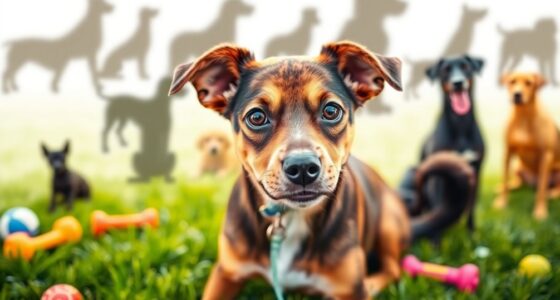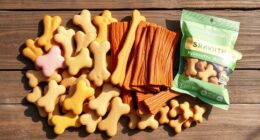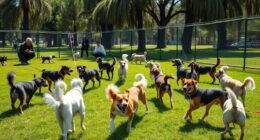If you’re choosing between an Alaskan Malamute and a Siberian Husky, you’ll notice key differences. Malamutes are larger, stronger, and more reserved, while Huskies are smaller, more energetic, and social. Malamutes prefer calm, open spaces, whereas Huskies adapt well to city life. Both need regular exercise and grooming, but their distinct temperaments and histories influence how they fit into your lifestyle. Continue exploring to discover more about their unique traits.
Key Takeaways
- Malamutes are larger, heavier, and more muscular, while Huskies are smaller, leaner, and built for speed.
- Malamutes have a more reserved, protective temperament; Huskies are outgoing, playful, and social.
- Malamutes tend to require more space and are better suited for large outdoor areas, whereas Huskies adapt well to city living.
- Malamutes have thicker coats and shed heavily, needing more grooming, while Huskies shed less and are easier to maintain.
- Both breeds are energetic and require daily exercise, but Huskies are more agile and faster, emphasizing their sled-pulling speed.
Physical Characteristics and Size
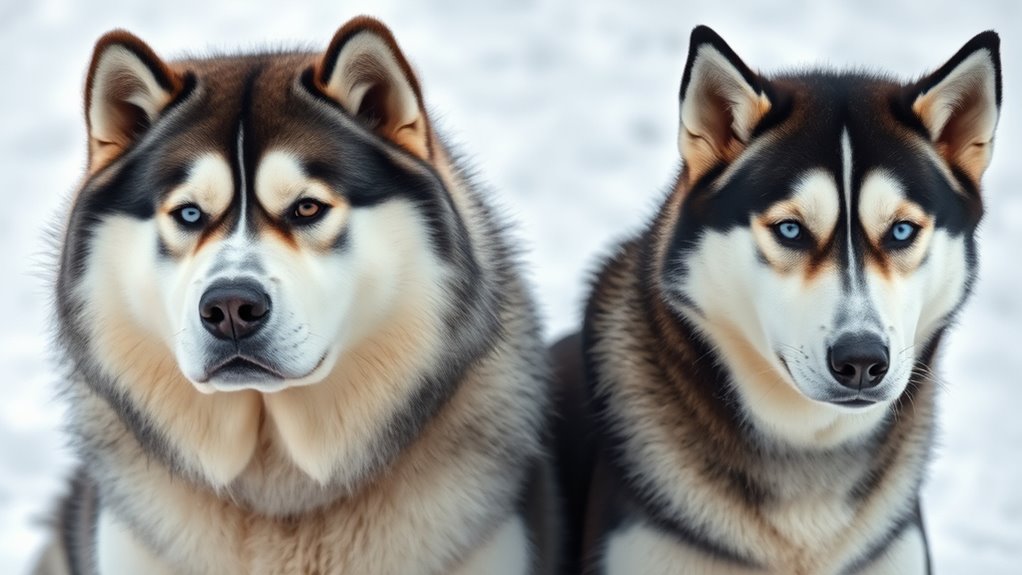
The Alaskan Malamute and Siberian Husky are both strong, muscular breeds with distinct physical traits. Their coat colors vary widely, from black, gray, sable, and red to pure white, allowing for diverse appearances. Malamutes tend to be larger, with a more robust build, and stand about 23 inches tall at the shoulder, weighing up to 100 pounds. Huskies are slightly smaller, reaching around 21 inches, with a leaner frame. Eye shapes also differ; Malamutes often have almond-shaped eyes, sometimes brown, blue, or heterochromatic, while Siberian Huskies typically feature striking blue or multicolored eyes. These physical features help distinguish the breeds and reflect their unique evolutionary adaptations. Additionally, understanding their physical differences can aid in selecting a breed suited to specific lifestyles and environments, especially since their physical characteristics influence their suitability for various climates and activity levels.
Temperament and Behavior

While both the Alaskan Malamute and Siberian Husky are friendly and outgoing, their temperaments differ in ways that influence how you interact with them. The Malamute has a more reserved nature but exhibits strong guarding instincts, making it cautious around strangers. The Husky, on the other hand, has a playful demeanor and is more social, often enthusiastic to make new friends. Malamutes tend to be loyal and protective, while Huskies are known for their independence and curiosity. These traits affect their behavior at home and in social settings. Here’s a quick comparison:
| Trait | Malamute | Husky | Similarities |
|---|---|---|---|
| Playful Demeanor | Moderate | Very playful | Both enjoy playtime |
| Guarding Instincts | Strong | Mild | Protective tendencies |
| Social Behavior | Cautious with strangers | Friendly with everyone | Outgoing personalities |
| Independence | Moderate | Very independent | Both can be stubborn |
| Loyalty | Very loyal | Loyal but more independent | Bond closely with owners |
Additionally, understanding their temperament and behavior helps in choosing the right breed for your lifestyle and environment. Recognizing their unique social tendencies can improve your training approach and ensure a harmonious relationship.
Exercise and Activity Needs

Both the Alaskan Malamute and Siberian Husky are highly energetic breeds that require plenty of exercise to stay healthy and happy. You’ll need to implement effective training methods that channel their energy positively, such as daily runs, fetch, or agility exercises. These breeds thrive on consistent activity, so aim for at least an hour of vigorous exercise each day. Their dietary requirements support their activity levels; high-quality, protein-rich diets help sustain their stamina and muscle mass. Incorporating proper socialization from an early age is essential to prevent behavioral issues and ensure they remain well-adjusted around other animals and people. Additionally, understanding their exercise needs can help you tailor activities to prevent overexertion, especially in hot weather. Monitoring their behavioral cues can help you recognize signs of fatigue or overheating, ensuring safe engagement. Using hybrid bikes as a form of low-impact exercise can be beneficial for maintaining their fitness without overtaxing their joints. Keep in mind that over-exercising, especially in hot weather, can cause issues. By establishing a routine that combines proper training and nutrition, you’ll help prevent boredom and destructive behaviors while ensuring your dog remains active, engaged, and well-balanced.
Grooming and Maintenance
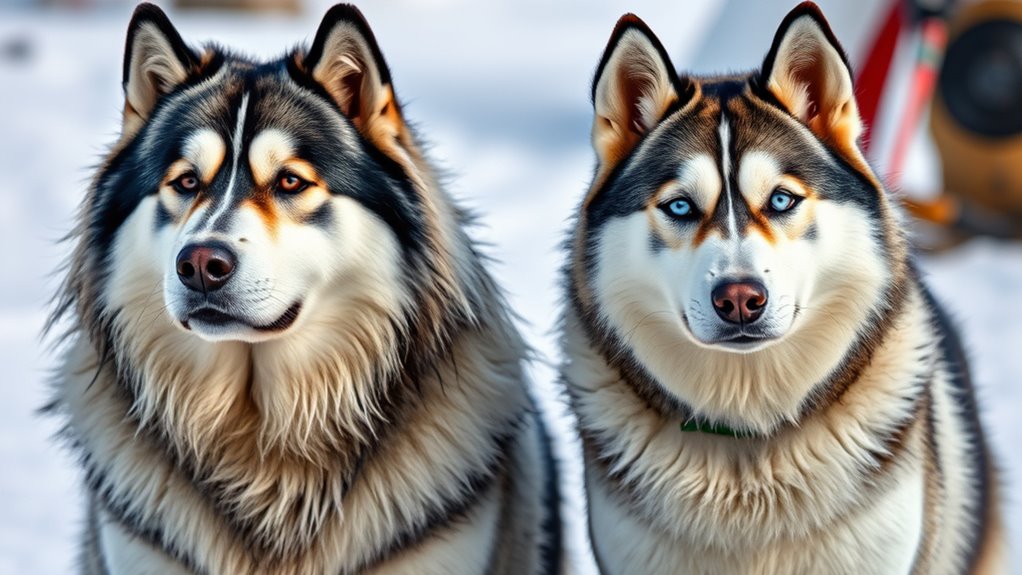
Given their high energy levels and active lifestyles, maintaining their coats is a key part of their overall care. Both breeds have thick coats that shed heavily, especially during shedding seasons. Regular grooming routines help manage this shedding and keep their coats healthy. You should brush their coats at least a few times a week, more often during peak shedding times, to remove loose hair and prevent matting. Siberian Huskies typically require less intensive grooming, but you still need to stay consistent. Malamutes, with denser coats, need more frequent brushing to keep their coats in good condition. Besides coat maintenance, routine checkups and keeping their ears and nails clean are essential parts of grooming. Staying consistent with grooming routines guarantees your dog stays comfortable and healthy. Proper grooming also supports coat health and can help identify early signs of skin issues or parasites. Additionally, using appropriate grooming tools tailored for dense coats can make the process more effective and comfortable for your pet. Regular grooming not only maintains their appearance but also promotes skin circulation, which is vital for overall skin health. Proper grooming techniques can also help reduce allergy triggers in sensitive dogs.
Health and Longevity
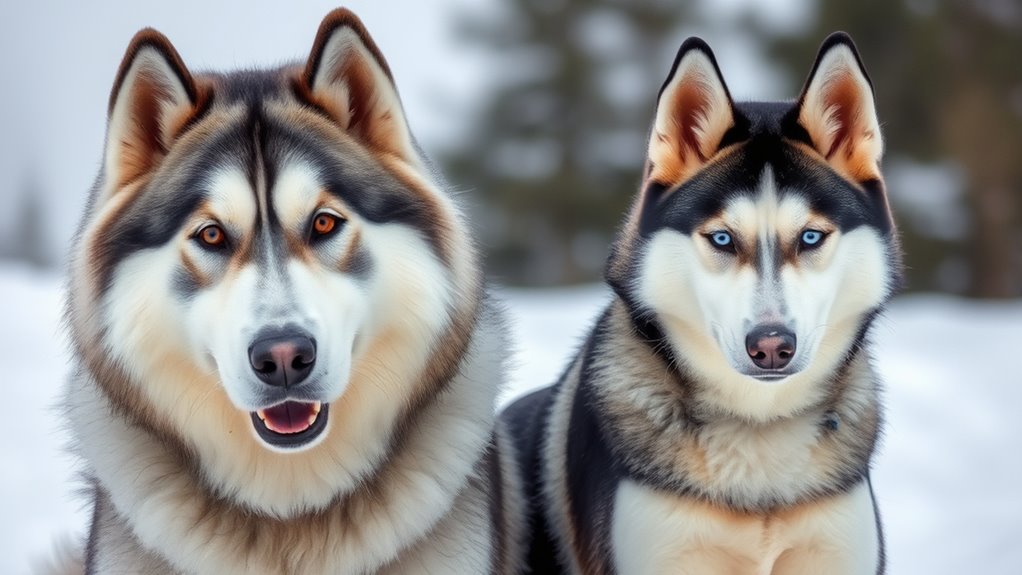
Alaskan Malamutes and Siberian Huskies are generally healthy breeds, but understanding their longevity and common health issues can help you provide better care. Both breeds have distinct genetic health concerns; Malamutes are prone to hip dysplasia and certain inherited disorders, while Huskies may face eye conditions like cataracts. Their lifespan comparison shows Malamutes typically live around 10-14 years, somewhat longer than Huskies, who average 12-15 years. Regular vet check-ups, a balanced diet, and exercise are essential to maintaining their health. Being aware of genetic health risks allows you to catch issues early and seek appropriate treatment. Breed-specific health considerations can guide you in providing targeted care. Proper care can notably improve your dog’s quality of life, and understanding genetic predispositions can aid in early detection and prevention of certain health problems. Additionally, staying informed about longevity factors can help you make better decisions for your pet’s well-being. Recognizing breed differences can also assist in tailoring their care to meet their specific needs.
Suitability for Different Lifestyles
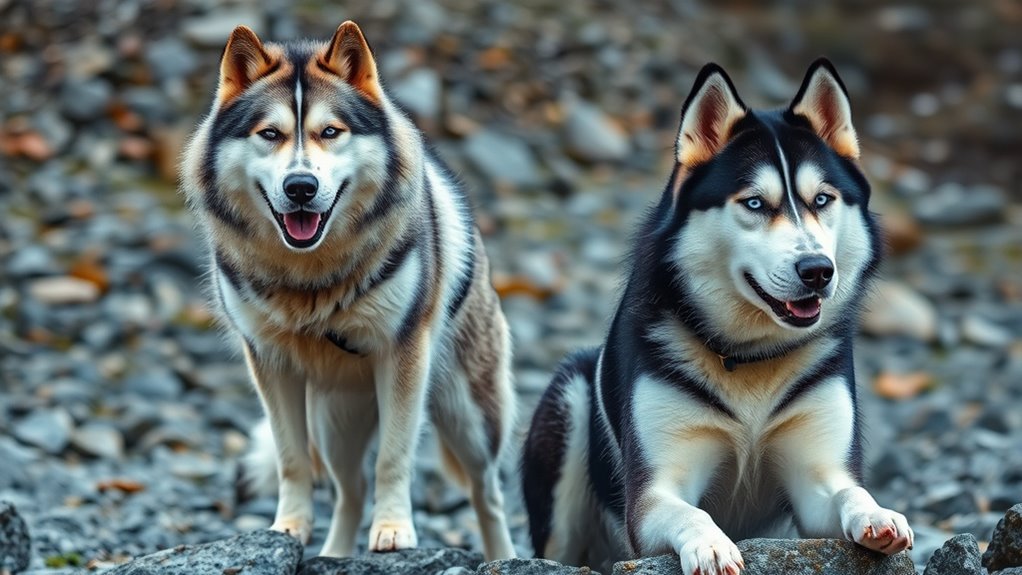
Alaskan Malamutes and Siberian Huskies have different needs that make them better suited to certain lifestyles. If you live in an urban environment, the Siberian Husky might be more adaptable due to its moderate size and energetic nature. Malamutes, on the other hand, thrive in spacious areas where they can exert their strength and independence. When it comes to family compatibility, Huskies tend to be friendly and playful, making them good companions for children. Malamutes are loyal but can be more reserved, requiring experienced owners. Consider these points:
- Urban adaptability: Huskies are generally better suited for city living.
- Exercise needs: Both breeds need regular activity, but Malamutes prefer more space to thrive in large areas.
- Family compatibility: Huskies are often more social and playful around kids.
- Additionally, Malamutes and Huskies have different exercise needs, with Malamutes generally requiring more space to thrive. Moreover, understanding their behavioral traits can help owners better meet their specific needs.
Origin and Historical Background
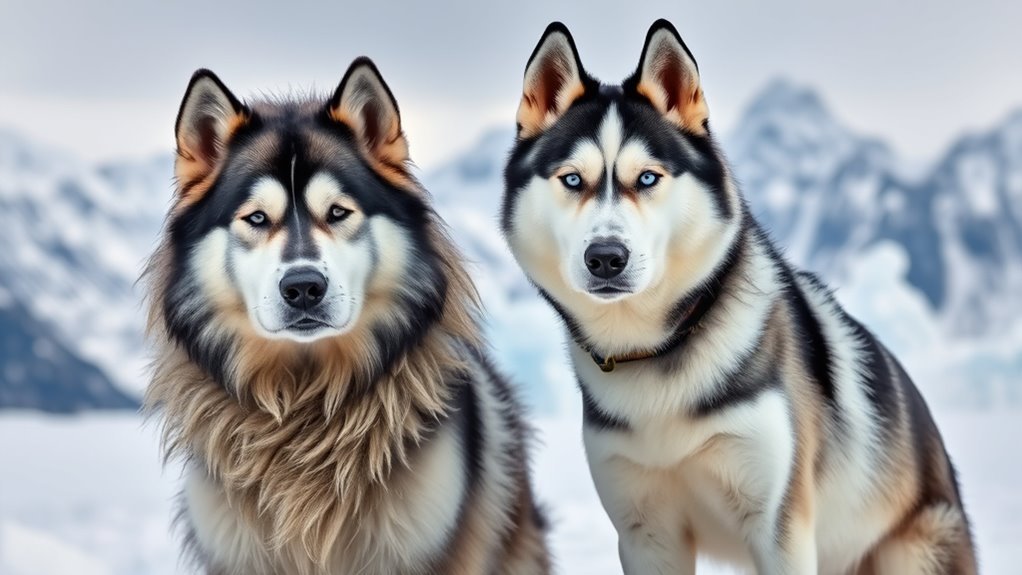
You’ll find that the Alaskan Malamute and Siberian Husky have distinct origins rooted in their native regions and heritage. Their historical roles reflect the needs of their ancestors, from heavy hauling to sled pulling. Understanding these backgrounds helps you appreciate how each breed was shaped by its environment and purpose. Additionally, the breed-specific traits of these dogs have been influenced by their unique evolutionary paths, which include adaptations to cold climates and endurance tasks. The credit card industry’s focus on secure online payment methods underscores the importance of safeguarding sensitive data, much like how these breeds were bred for specific environmental challenges.
Native Regions and Heritage
Have you ever wondered where these powerful sled dogs originated? Both the Alaskan Malamute and Siberian Husky have rich native origins and deep cultural significance. The Malamute descends from the Mahlemuts of Alaska, known for their strength and endurance in harsh Arctic conditions. Meanwhile, the Siberian Husky comes from Siberia, bred by the Chukchi people for pulling sleds across icy terrain. These breeds symbolize survival and resilience within their native regions.
- The Malamute is linked to the Alaskan native tribes’ hunting and hauling traditions.
- The Siberian Husky holds an essential place in Siberian indigenous culture.
- Both breeds embody the history and resourcefulness of their native peoples.
- The native regions where these breeds developed heavily influenced their physical characteristics and working abilities.
- The distinct environmental conditions of their native regions contributed significantly to their unique adaptations and traits.
- These environmental pressures fostered specialized traits that help each breed thrive in extreme climates.
Historical Roles and Uses
Both the Malamute and Siberian Husky played essential roles in their native regions, serving as indispensable working dogs for their peoples. They were primarily used as sled dogs, helping tribes travel across vast, icy landscapes. The Malamute, known for its strength and endurance, was often tasked with hauling heavy loads, making it ideal for long-distance hauling and mountain work. Siberian Huskies, lighter and faster, excelled in pulling lighter loads over shorter distances. These dogs were crucial for transportation, hunting, and survival in harsh climates. Their working roles shaped their breeds’ stamina, resilience, and social nature. Over time, their unique skills and adaptations made them indispensable members of their communities, ensuring their survival and success in extreme environments. Additionally, these breeds have been depicted in artistic representations, highlighting their cultural significance and historical importance.
Frequently Asked Questions
Which Breed Is More Popular as a Family Pet?
When choosing a family pet, popularity often depends on temperament and care needs. Siberian Huskies tend to be more popular because they’re energetic and friendly, but they require regular exercise and dog grooming to keep their coats healthy. Alaskan Malamutes are great too but need more training and grooming. Consider your lifestyle—if you can meet their exercise requirements and grooming needs, either breed can make a loving family companion.
Are Both Breeds Suitable for First-Time Dog Owners?
Think of choosing a dog as picking a new adventure partner—you need to match your experience. Both breeds can be wonderful, but they’re not ideal for first-time owners. Siberian Huskies and Malamutes have high exercise needs and grooming requirements, which can be overwhelming. If you’re new to dog ownership, consider a breed with lower maintenance to make sure a positive experience for both of you.
How Do Their Trainability Levels Compare?
When comparing their trainability levels, you’ll find that Siberian Huskies tend to be more independent, making obedience training a bit more challenging. They require consistent socialization skills to prevent stubbornness. Alaskan Malamutes are generally enthusiastic to please, which helps with obedience training, but they also need early socialization to develop good social skills. Overall, Huskies might test your patience more, but both breeds benefit from positive reinforcement and early training.
Which Breed Is More Prone to Specific Health Issues?
You should know that Siberian Huskies are more prone to genetic disorders like cataracts and autoimmune diseases, which can affect their health. Alaskan Malamutes tend to have issues such as hip dysplasia and obesity. Regarding lifespan, Huskies generally live longer, often 12-15 years, while Malamutes average around 10-14 years. So, consider these health tendencies when choosing your future canine companion.
Can They Live Comfortably in Urban Environments?
You might wonder if these breeds can adapt well to urban living. Both dogs have moderate urban adaptability, but they thrive best with plenty of exercise and mental stimulation. If you live in an apartment, guarantee daily walks and playtime to keep them happy. Siberian Huskies tend to handle smaller spaces better, but Malamutes need more room. Proper training and activity are essential for a comfortable, happy relationship in city environments.
Conclusion
Now that you know the key differences between Alaskan Malamutes and Siberian Huskies, it’s clear each breed has its own unique charm. Whether you’re drawn to the Malamute’s strength or the Husky’s spirited personality, choosing the right companion depends on your lifestyle. Remember, don’t judge a book by its cover—get to know their individual needs and quirks before making your decision. After all, the proof of the pudding is in the eating!



